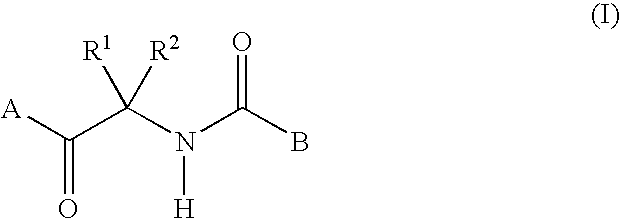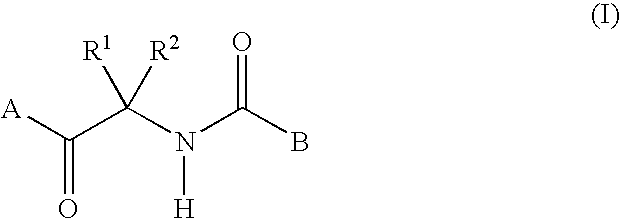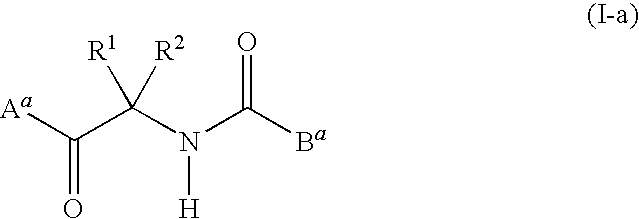Fungicidal composition containing carboxylic acid amide derivative
a technology of carboxylic acid and derivative, applied in the direction of biocide, heterocyclic compound active ingredients, organic chemistry, etc., can solve the problems of insufficient effect, insufficient residual effect, and inability to prevent, so as to effectively control noxious fungi and improve crop yield
- Summary
- Abstract
- Description
- Claims
- Application Information
AI Technical Summary
Benefits of technology
Problems solved by technology
Method used
Image
Examples
preparation example 1
Preparation of N-[(3′-difluoromethoxy-1,1-dimethyl)phenacyl]-3-trifluoromethyl-2-pyridinecarboxamide (after-mentioned compound No. 1-21)
[0193](1) A Grignard reagent prepared by using 0.75 g of magnesium, 4.46 g of 2-bromopropane and 24 ml of anhydrous diethyl ether, was dropwise added to a mixture comprising 4.09 g of 3-difluoromethoxybenzonitrile and 20 ml of anhydrous diethyl ether. After completion of the dropwise addition, the mixture was reacted at room temperature for 27 hours. The reaction mixture was put into ice water, and 6N sulfuric acid was added to bring the mixture to be weakly, acidic, followed by stirring for 0.5 hour. The mixture was extracted with diethyl ether and washed with water. The organic layer was dried over anhydrous magnesium sulfate and then concentrated under reduced pressure. The residue was purified by silica gel column chromatography (developing solvent: ethyl acetate / n-hexane=1 / 19), to obtain 2.04 g of 3-difluoromethoxyisobutyrophenone. The NMR spec...
preparation example 2
Preparation of N-[(3′,4′-dichloro-1,1-dimethyl)phenacyl]-3-trifluoromethyl-2-pyridinecarboxamide (after-mentioned compound No. 1-9)
[0199](1) A mixture comprising 10.0 g of 3,4-dichlorobenzoyl chloride, 9.31 g of ethyl 2-bromoisobutyrate and 90 ml of anhydrous diethyl ether, was dropwise added to 3.12 g of zinc in a nitrogen atmosphere, followed by a reaction for 15 hours under reflux. The reaction mixture was filtered through celite, and the filtrate was washed with 20% sulfuric acid and then with water. The organic layer was dried over anhydrous magnesium sulfate and then concentrated under reduced pressure. The residue was purified by silica gel column chromatography (developing solvent: ethyl acetate / n-hexane=1 / 19) to obtain 8.7 g of oily ethyl 2-(3′,4′-dichlorobenzoyl)isobutyrate. The NMR spectrum data of this product is as follows.
[0200]1H-NMR δppm (Solvent: CDCl3 / 400 MHz)
[0201]1.11 (t, 3H), 1.52 (s, 6H), 4.14 (q, 2H), 7.48 (d, 1H), 7.63 (dd, 1H), 7.96 (d, 1H)
(2) A mixture comp...
preparation example 3
Preparation of N-[(4′-methoxy-2′-methyl-1,1-dimethyl)phenacyl]-3-trifluoromethyl-2-pyridinecarboxamide (after-mentioned compound No. 1-3)
[0210](1) A mixture comprising 5.7 g of isobutyryl chloride and 5 ml of carbon disulfide, was dropwise added to a mixture comprising 7.15 g of aluminum chloride and 20 ml of carbon disulfide at a temperature of not higher than 10° C., followed by a reaction for 0.5 hour. Then, a mixture comprising 5.0 g of m-cresol and 5 ml of carbon disulfide, was dropwise added at a temperature of not higher than 5° C., followed by a reaction for 4 hours at room temperature. The reaction mixture was put into a mixture of ice water and hydrochloric acid and extracted with methylene chloride, followed by washing with water. The organic layer was dried over anhydrous sodium sulfate and then concentrated under reduced pressure. To the residue, 60 ml of tetrahydrofuran, 30 ml of water and 3.7 g of sodium hydroxide were added, followed by a reaction for 1.5 hours at ro...
PUM
| Property | Measurement | Unit |
|---|---|---|
| reaction temperature | aaaaa | aaaaa |
| reaction temperature | aaaaa | aaaaa |
| reaction temperature | aaaaa | aaaaa |
Abstract
Description
Claims
Application Information
 Login to View More
Login to View More - R&D
- Intellectual Property
- Life Sciences
- Materials
- Tech Scout
- Unparalleled Data Quality
- Higher Quality Content
- 60% Fewer Hallucinations
Browse by: Latest US Patents, China's latest patents, Technical Efficacy Thesaurus, Application Domain, Technology Topic, Popular Technical Reports.
© 2025 PatSnap. All rights reserved.Legal|Privacy policy|Modern Slavery Act Transparency Statement|Sitemap|About US| Contact US: help@patsnap.com



